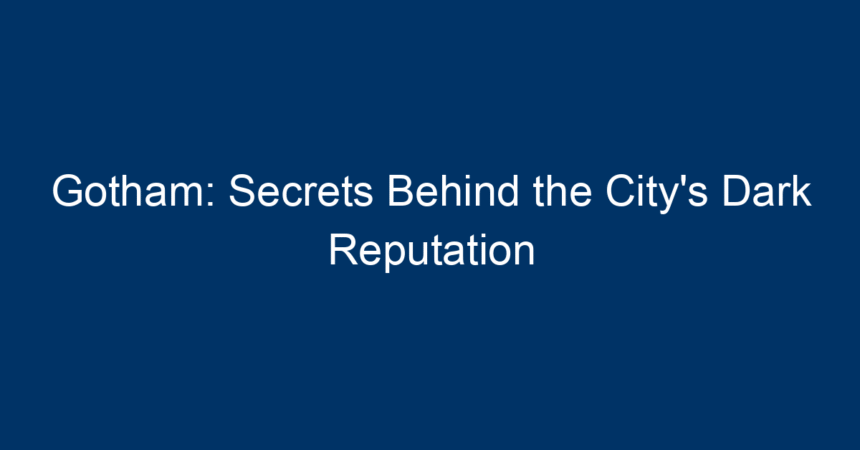Gotham City has long captivated audiences with its enigmatic aura and chilling narrative. From its rich comic book history to its portrayal in films and television series, Gotham paints a picture of urban decay, crime, and complex moral dilemmas. But what is it that gives Gotham its dark reputation? In this article, we will uncover the secrets behind this iconic city, exploring its history, notable characters, and the cultural impacts that have made it a symbol of darkness.
The Origins of Gotham’s Dark Reputation
Historical Context
Gotham’s roots can be traced back to ancient mythologies and literature. The name itself has been used historically in English literature to describe a place of foolishness. However, it wasn’t until the creation of Batman in 1939 by Bob Kane and Bill Finger that Gotham began to take on its contemporary dark persona. The introduction of a superhero fighting against crime in an ever-deteriorating city highlighted the contrasting themes of hope and despair.
Architectural Influence
The city’s gothic architecture plays an essential role in its dark aesthetic. Iconic structures such as Gotham Cathedral and Arkham Asylum provide a haunting backdrop for its notorious events. These buildings, often illustrated with sharp, jagged lines and intricate designs, speak to the city’s tumultuous history and the lurking evil within its skyline.
The Underbelly of Gotham
Crime and Corruption
Gotham is characteristically known as a hotbed for crime. This notoriety stems from a myriad of nefarious organizations such as the Gotham mob, the Scarecrow’s fear-induced manipulations, and the Joker’s chaotic antics. This criminal culture highlights the systemic corruption that has plagued the city, with officials often depicted as either complicit in or powerless against the tide of crime.
Notable Villains
At the heart of Gotham’s darkness are its villains. Characters like the Joker, Penguin, and Riddler serve as stark reminders of the chaos that can thrive in a city when good is pitted against evil. The Joker, in particular, symbolizes the chaotic nature of Gotham, embodying the idea that beneath the surface of civilization lurks insanity and violence. Each villain represents different aspects of Gotham’s psyche and social issues, from economic disparity to psychological trauma.
The Trauma of Its Citizens
The residents of Gotham face a perpetual cycle of fear and resilience. Trauma is a recurring theme, with characters like Bruce Wayne grappling with the loss of his parents, shaping his path as Batman. This personal tragedy reflects the broader struggles of Gotham’s citizens, who contend with their own shadows every day.
Cultural Reflections: Gotham in Media
Television and Film
Gotham City has been depicted in various forms of media, with each iteration adding layers to its reputation. The critically acclaimed show Gotham explores the origins of its characters and the genesis of its crime-ridden landscape. Films such as The Dark Knight trilogy further amplify the city’s darkness, illustrating the complexities of heroism and villainy.
Comic Book Evolution
Over the decades, Gotham has evolved in comic book portrayals, transitioning from a mere backdrop to a character in its own right. Writers like Frank Miller and Scott Snyder have delved deep into the psychological and societal implications of living in such a broken city. This nuanced portrayal fosters discussions about morality, justice, and the impact of environment on individual behavior.
The Psychological Impact of Living in Gotham
The City as a Character
Gotham often feels like a character with its own agenda. The shadows and alleys act as silent witnesses to the city’s dramatic tales, and each street corner has a story to tell. This personification enhances the dark reputation and encapsulates the feeling of entrapment faced by its residents.
Collective Trauma and Resilience
The ongoing struggle against crime cultivates a communal bond among Gotham’s citizens. While they might contend with high levels of anxiety and fear, there’s also an underlying sense of resilience. This duality—fear and strength—captures the essence of living in Gotham, a city where darkness doesn’t just lurk; it is lived through every day.
Dissecting Gotham’s Symbolism
A Mirror to Real-World Issues
Gotham City serves as a metaphor for real-world urban problems. Issues such as poverty, violence, and systemic corruption are prevalent both in the fictional city and in reality. The struggles faced by those in Gotham mirror societal challenges, making its narrative relevant even beyond the pages of comic books and screenplays.
The Balance of Hope and Despair
While Gotham projects an image of despair, it also showcases hope. The existence of Batman symbolizes the fight against hopelessness. This balance raises questions about the nature of good and evil, challenging viewers to reflect on their own lives and moral compasses. Gotham’s intricate dance between darkness and light invites contemplation about the human condition.
The Future of Gotham
Evolution in Storytelling
As the world evolves, so does Gotham. New narratives are emerging that challenge traditional notions of heroism and villainy. As diversity and representation become more central in storytelling, Gotham’s future can lead to richer, more inclusive portrayals of its characters and themes.
The Legacy Continues
Gotham’s reputation as a dark city is likely to endure. As long as stories of heroism and villainy continue to captivate audiences, Gotham will remain a tapestry of shadowy tales. The continuous evolution of its characters and their struggles ensures that the city will remain relevant in cultural dialogues for years to come.
Conclusion: Actionable Insights
Understanding the depth of Gotham’s dark reputation offers valuable lessons in storytelling, resilience, and the human experience. Whether through exploring its rich history or analyzing its cultural impact, there are several insights one can derive:
-
Emphasize Complexity: In storytelling, avoid black-and-white portrayals. Characters should have depth, showcasing human complexities that resonate with audiences.
-
Reflect Society: Use fictional narratives to dive deep into real-world issues, helping audiences to confront and reflect upon societal challenges.
- Balance Darkness with Hope: While exploring difficult themes, remember to introduce elements of hope and resilience to inspire your audience.
By uncovering the secrets behind Gotham’s dark reputation, we not only appreciate the rich lore surrounding the city but also find reflections of our own lives within its shadows. Whether you’re watching a film, reading a comic, or simply pondering the complexities of human nature, Gotham remains an inexhaustible source of intrigue and insight.




